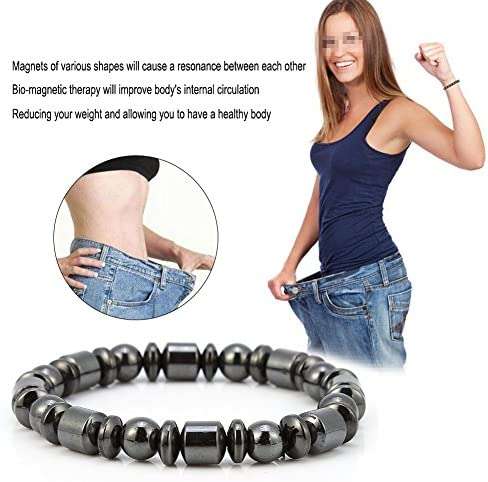Can magnets help with pain?
With the alternative medicine industry as popular as ever, it should come as no surprise that some product claims are more than dubious, if not flat out untrue.
Popular even in Cleopatra’s time, the belief in magnetic bracelets as a cure-all continues to be a hotly debated topic. Scientists, businesspeople, and people seeking relief from pain and disease all have their own opinions.
Today, you can find magnets in socks, compression sleeves, mattresses, bracelets, and even athletic wear. People use them to treat pain caused by arthritis as well as pain in the heel, foot, wrist, hip, knee, and back, and even dizziness. But do they really work?
Where the theory comes from
The theory behind using magnets for medicinal purposes stems from the Renaissance period. Believers thought that magnets possessed a living energy, and they would wear a bracelet or piece of metallic material in the hope of fighting disease and infections or to relieve chronic pain. But with advancements in medicine through the 1800s, it didn’t take long before magnets came to be seen as worthless, even dangerous therapeutic devices.
Magnetic therapy enjoyed a resurgence in the 1970s with Albert Roy Davis, PhD, who studied the different effects that positive and negative charges have on human biology. Davis claimed that magnetic energy could kill malignant cells, relieve arthritis pain, and even treat infertility.
Today, sale of magnetic products for pain treatment is a multibillion-dollar industry worldwide. But despite another stint in the spotlight, recent studies have determined that evidence is inconclusive.
So, do they really work?
According to the vast majority of research, the answer is no. Davis’ assertions and a 1976 study have been largely disproven, and there’s little to no evidence that magnetic bracelets have any future in pain management.
A 2007 review of research concluded that magnetic bracelets aren’t effective at treating pain caused by osteoarthritis, rheumatoid arthritis, or fibromyalgia. Another, from 2013, agreed that both magnetic and copper wristbands have no more effect on pain management than placebos. The bracelets were tested for their effects on pain, inflammation, and physical function.
According to the National Center for Complementary and Integrative Health (NCCIH), static magnets, like those in a bracelet, don’t work. They warn people not to use any sort of magnet as a replacement for medical attention and treatment.
Are magnets dangerous?
Most magnets marketed for pain relief are made from either pure metal — like iron or copper — or alloys (mixtures of metals or of metals with nonmetals). They come in strengths between 300 and 5,000 gauss, which is nowhere near as strong as the magnetic force of magnets you find in things like MRI machines.
While they’re generally safe, the NCCIH warns that magnetic devices can be dangerous for certain people. They caution against using them if you also use a pacemaker or insulin pump, as they might cause interference.
The takeaway
Despite the popularity of magnetic bracelets, science has largely disproven the effectiveness of such magnets in treating chronic pain, inflammation, disease, and general health deficiencies.
Don’t use magnets as a replacement for proper medical attention, and avoid them if you have a pacemaker or use an insulin pump.
Americans spend millions of dollars on metallic bracelets for their supposed health benefits. Many manufacturers market their products as alternatives to traditional medical care. But is there any truth to these claims?
A metallic bracelet is an accessory, worn on the wrist or ankle, that is part or all metal. Examples include:
What Are Metallic Bracelets Used For?
Companies that sell copper or magnetic metallic bracelets claim that their products can ease rheumatoid arthritis pain. Other health claims include:
- Better blood circulation
- Toxin removal
- Pain relief
- Less inflammation through dilation of blood vessels
- Less stiffness
- More energy
- Faster recovery and healing
Metallic bracelets made of different materials have different uses. For example, gold bracelets are said to improve brain function, while silver bracelets may ward off infections and boost the immune system.
The common thing among all these claims is that there is not enough scientific evidence to prove or disprove them. There haven’t been enough studies carried out to show that metallic bracelets don’t work. But most of the research that’s been done has found claims about their effectiveness to be partly or completely false.
There are no scientific studies that support the effectiveness of magnetic bracelets in improving the sperm count of humans
At a glance
- Claim: Magnetic therapy healthcare bracelet improves sperm count.
- Rating: FALSE
- The facts: There are no scientific studies that support the effectiveness of magnetic bracelets in improving the sperm count of an individual.
- Why we fact-checked this: The post containing the claim has over 1,200 reactions, 225 comments, and 113,000 views on Facebook, as of writing.
Complete details
A post on July 13 by the Facebook page “L-Nitomaey.A” claims that magnetic therapy bracelets improve the sperm count of an individual.
This is false.
There are no scientific studies that support the effectiveness of magnetic bracelets in improving the sperm count of humans.

There are published studies on the topic, but they used mice and boars as test subjects, and they did not use wearable magnets in their respective experiments. Both studies did not observe any exposure-related differences in the sperm count of the test subjects.
Health website Health Line said that prior to being marketed as a treatment for male fertility issues, magnetic bracelets were also marketed for different types of pain.
The National Center for Complementary and Integrative Health already debunked these claims and said that static magnets like those found in magnetic bracelets do not work as a replacement for medical attention or treatment. – Lorenz Pasion/Rappler.com
Keep us aware of suspicious Facebook pages, groups, accounts, websites, articles, or photos in your network by contacting us at [email protected]. You may also report dubious claims to #FactsFirstPH tipline by messaging Rappler on Facebook or Newsbreak via Twitter direct message. You may also report through our Viber fact check chatbot. Let us battle disinformation one Fact Check at a time.
If you live with severe pain, I’m sure you’ll try just about anything to get relief –I know I would. So maybe you’re thinking about giving a magnetic bracelet a try because they claim to have great medicinal properties. Well, here comes the big question, do they really work?
Magnetic bracelets have been popularized as an alternative treatment to alleviate pain and address health issues. Static magnets are used in jewelry items, commonly bracelets, to theoretically treat diseases and pain. They are thought to have properties that improve circulation and decrease inflammation to ease pain through the magnetic field that is created by the magnets.
Debunking the myth of magnetic bracelets
Scientific studies have ultimately shown that there is no evidence to support any healing or therapeutic claims other than a placebo effect. Often these bracelets will claim to be great for treating pain from arthritis, reducing inflammation, decreasing joint pain, and expelling harmful toxins. Considering recent studies and reviews of these claims, this has been disproven.
According to Stephen Barret, M.D., “there is no scientific basis to conclude that small, static magnets can relieve pain. In fact, many of today’s products produce no significant magnetic field at or beneath the skin’s surface.”
The National Center for Complementary and Integrative Health (NCCIH) even warns to not use these magnets as a substitution for professional medical care, and that it can even be harmful to those using a pacemaker or insulin pump. Some side effects of using stronger magnets on the body may include:
- Pain
- Nausea
- Dizziness
- Skin irritation
The majority of research has come to the conclusion that these beneficial health claims are false and magnetic bracelets cannot effectively be used to treat arthritis and other diseases or symptoms of chronic pain.
If magnetic bracelets don’t work, what’s the alternative?
You should always consult your physician about health decisions and treatment plans for your specific condition. If you have lingering back and neck pain, arthritis, fibromyalgia, or severe joint pain, don’t go straight to the option of magnetic therapy bracelets. You would benefit from visiting a physical therapist instead who specializes in ways to offer you pain relief and measurable improvement.
Luna offers alternatives to the typical clinic visits through on-demand physical therapy. That means you’ll have access to your own personal PT through in-person visits wherever and whenever it is convenient for you and virtual televisits for one-on-one specialized care. You’ll also be able to easily track and monitor the progress of your personalized treatment plan via the Luna App. This includes in-app exercises and easy ways for your PT to see what progress you’re making to adjust your plan as needed.
Don’t let the myth fool you, magnetic bracelets won’t give you the results you are looking for. On-demand PT is a faster, safer, and easier-than-ever way for patients to heal and receive the care that you need. Get in touch with us today, we can’t wait to help!
Handpicked Resources for You
10 Daily Habits for Arthritis Pain Relief – Everyday Health
Do Copper Bracelets Help With Arthritis? – Medical News Today
Copper Bracelets and Magnetic Wrist Straps for Rheumatoid Arthritis – Analgesic and Anti-Inflammatory Effects – Plos One Scientific Journal
Copper Bracelets ‘Don’t Help Rheumatoid Arthritis’ – WebMD



